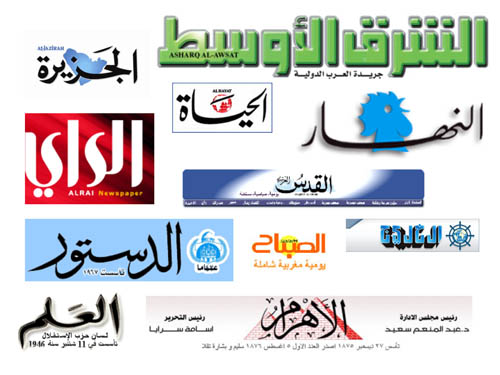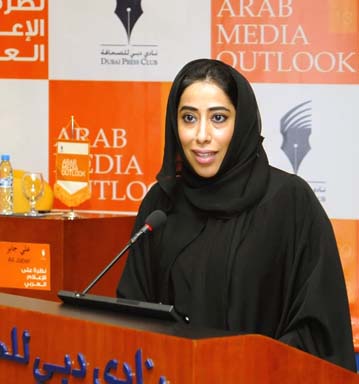Print media in the west may be struggling for survival but newspapers in the Arab world, which took a few hits, are nonetheless thriving and expected to grow, a recent study showed.
Despite the overall challenging environment, the Middle East print industry has weathered the storm better than other markets, according to the Arab Media Outlook 2009-2013.

"While other markets are struggling to maintain, let alone increase circulation of newspapers, in the Arab Region, we expect the circulation of daily newspapers to continue to grow over the next five years, albeit at a slower pace than before," the third such annual survey commissioned by the Dubai Press Club, said.
Walking past most Arab newsstands, one comes across a plethora of publications, seemingly debunking myths about expensive newsprint and glossy paper straining budgets, or a shortage of readers affecting business.

Unlike layoffs in American and European print media, consolidation of newspaper assets, shrinking circulation and advertising, competition with online media, and, cost-cutting measures, Arab newspaper industry officials see stable to healthy expansion in coming years.
New York Times publisher Arthur Sulzberger, Jr. may have said the printed Times' future was in question, but that bleak picture is not reflected in many Arab markets.
The U.S. saw a 4% decline in total circulation between 2003 and 2008 as the Arab region enjoyed rising circulation figures, although the total number of daily newspaper titles stalled between 2008 and 2009, the survey found.
"Growth will be driven not only by a strong increase in circulation in the largest market Egypt, but also by some of the smaller Gulf countries, such as Bahrain and Qatar," it said.
The growth will stem from countries where newspapers are the preferred medium, it noted, adding that Egypt was home to a thriving newspaper industry, with some of the oldest and newest papers on the market.
Egypt's Al Ahram, for example, is government-owned but was established in 1876 by Lebanese expatriates Salim and Bechara Takla. Newer titles like Al Masry Al Youm are considered independent newspapers. Both have growth potential.
The print industry in the region has further room to grow given the unsaturated market in the majority of Arab countries, according to the study.
"The concentration of newspapers in the region relative to its population remains low compared to Western Europe, North America and even Eastern Europe," it said.
However, there is wide disparity between countries, with Gulf states such as Bahrain, Qatar and Kuwait considered "saturated," while others expected to present room for growth.
Some key markets, including Jordan, Saudi Arabia and Syria, could benefit from an increase in newspapers, the study projected.
But one should not be misled by the bountiful displays and growing market figures.
The Arab print media industry has suffered some setbacks with Morocco's Assabahia and Assada El Massaia folding, Egypt's El Badeel calling it quits three years into its run, and, Lebanon's The Daily Star teetering on the brink of bankruptcy in 2009.

Arab newspaper logos
Even oil-rich Gulf countries have had to squeeze expenses.
Kuwaiti newspaper Assawt closed shop after four months of existence, and the United Arab Emirates' free newspaper 7 Days shuttered its Friday publication in 2009 in an effort to increase efficiency, the study said.
Friday is the Moslem holy day and weekend editions in the Gulf are usually quite meaty.
The survey also said some newspapers were moving to pure online editions.
Saudi Arabia's Al Majalla, once a substantive weekly magazine, turned to an e-paper format in 2009.
On the cyber front, the Internet has started to impact the print industry in the region, the study said, underlining the amount of time Arabs spend browsing.
"With news being one of the most popular forms of content among the young demographic in the Arab region, it is not surprising that consumption is moving online, with 40% of news readers accessing news via the Internet in 2009," it said.
The United Arab Emirates' English-language daily Gulf News was a pioneer in introducing video news on its website.

News is not only sought from traditional Arab media sites but from blogs, the study acknowledged.
But, it pointed out, despite the increasing popularity of blogs and social media in the Arab world, over 80% of industry experts interviewed for the survey said they did not feel threatened by user-generated content.
Print revenues in the region have suffered from the recession but have shown more resilience than international markets, the study revealed.
"Our research into the changing dynamics of the media in our part of the world taught us that very many new opportunities abounded alongside the challenges," wrote Mona Al Marri, the Dubai Press Club's chairperson, in the introduction.

Dubai Press Club chairperson Mona Al Marri (DPC)
She struck a note of guarded optimism, adding that Arab media were strong enough to not only withstand the storms of the times, but to forge ahead and rectify any previous missteps.
